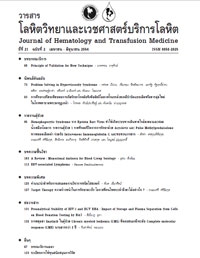Problem Solving in Hyperviscosity Syndrome
Keywords:
Plasma viscosity, Plasma exchange, yperviscosity syndrome, Multiple myeloma, Rouleaux formationAbstract
บทคัดย่อ
Hyperviscosity syndrome เกิดจากการที่ร่างกายมีความหนืดของเลือดเพิ่มขึ้น เนื่องจากมีปริมาณอิมมูโนโกลบุลิน (IgG) ในเลือดสูง วัตถุประสงค์ : เพื่อรายงานโรค multiple myeloma ที่มี hyperviscosity syndrome จำนวน 1 ราย ผู้ป่วยชายไทย อายุ 54 ปี ซีด เลือดกำเดาไหลบ่อย เลือดหนืดมาก เครื่องตรวจนับเม็ดเลือดอัตโนมัติ ดูดเลือดมาตรวจ CBC ไม่ได้ สเมียร์เลือดพบ rouleaux formation การตรวจไขกระดูกพบ plasma cells ที่ผิดปกติร้อยละ 90 การตรวจทางภูมิคุ้มกัน ซีรัมหนืดคล้ายเจล เนื่องจากปริมาณ IgG สูง จำเป็นต้องใช้ phosphate buffer saline มาเจือจางซีรัม การตรวจ serum protein electrophoresis และ urine protein electrophoresis พบ monoclonal gammopathy การตรวจหมู่เลือดเป็นหมู่ O, RhD positive การตรวจ direct antiglobulin ให้ผลลบ การตรวจกรองแอนติบอดีในซีรัมด้วยวิธี standard tube test ที่อุณหภูมิห้องอ่านไม่ได้เพราะเลือดหนืด จึงอ่านผลที่อุณหภูมิ 37 ํซ. พบว่ามี rouleaux formation แต่ที่ antiglobulin phase ให้ผลลบ การตรวจแยก rouleaux formation ออกจากปฏิกิริยาการจับกลุ่มทำด้วยวิธี saline replacement technique การตรวจกรองแอนติบอดีในซีรัมด้วยวิธี gel test ให้ผลคล้าย mixed field agglutination ซึ่งเป็นผลบวกปลอม การทำautocontrol พบ rouleaux formation เช่นเดียวกับการตรวจกรองแอนติบอดี การตรวจความเข้ากันได้ระหว่างซีรัมผู้ป่วยและเม็ดเลือดแดงของผู้บริจาคหมู่ O พบ rouleaux formation ที่อุณหภูมิ 37 ํซ. แต่ที่ antiglobulin test ให้ผลลบ ผู้ป่วยได้รับการรักษาด้วยการทำplasma exchange หลังทำผู้ป่วยดีขึ้น เลือดไม่หนืด plasma viscosity 1.14 cP แต่ยังคงซีด Hb 5.54 g/dL Hct 16.7% จึงได้รับเม็ดเลือดแดง 3 ยูนิต สรุป : รายงานการพบผู้ป่วย hyperviscosity syndrome ที่เกิดจาก IgG multiple myeloma IgG ซึ่งมีปริมาณมากมีผลกระทบต่อการตรวจทางห้องปฏิบัติการ การตรวจกรองแอนติบอดี และการตรวจความเข้ากันได้ของเลือด การนำphosphate buffer saline มาเจือจางซีรัม หรือการนำเลือดไปอุ่นที่อุณหภูมิ 37 ํซ. ช่วยแก้ปัญหาได้ การทำplasma exchange เพื่อลดความหนืดของเลือด มีประโยชน์ต่อการรักษาผู้ป่วยที่มีภาวะดังกล่าว
Key Words : Plasma viscosity ; Plasma exchange ; yperviscosity syndrome ; Multiple myeloma ; Rouleaux formation
Abstract
Hyperviscosity syndrome refers to the clinical sequelae of increased blood viscosity resulting from increased immunoglobulin in blood circulation. An interesting case of multiple myeloma with hyperviscosity syndrome was reported. A 54-year-old man was presented with epistaxis and anemia. The blood sample was failed to operate on the automated hematology analyzer due to high plasma viscosity. Peripheral blood smear showed rouleaux formation. The bone marrow was nearly entirely replaced by the abnormal plasma cells. The high amount of IgG caused gel-like serum pattern. The serum and urine protein electrophoresis revealed monoclonal gammopathy. Blood grouping was O, RhD positive with negative direct antiglobulin test. The antibody screening at room temperature by standard tube test was failed due to viscous serum. The antibody screening and autocontrol were done at 37 ํC and antiglobulin test, respectively. Rouleaux formation was found at 37 ํC but negative at antiglobulin phase. Saline replacement technique was used to separate rouleaux formation from antigen-antibody reaction. The antibody screening by gel test resembled mixed field agglutination but the result was false positive. Crossmatching between patient’s serum and group O red cells showed rouleaux formation at 37 ํC but negative at antiglobulin phase. Plasma exchange was performed and hyperviscosity syndrome was resolved. After plasma exchange, the plasma viscosity was 1.14 cP. He was anemia, Hb 5.54 g/dL and Hct 16.7%, so three units of packed red cells were given. Conclusion : A case of IgG multiple myeloma with hyperviscosity syndrome was detected. The high amount of IgG affected the laboratory evaluation including antibody screening and crossmatching. Diluting serum with phosphate buffer saline or warming serum at 37 ํC solved the problem. Plasma exchange to reduce blood viscosity showed the benefits for these conditions.
Key Words : Plasma viscosity ; Plasma exchange ; yperviscosity syndrome ; Multiple myeloma ; Rouleaux formation


